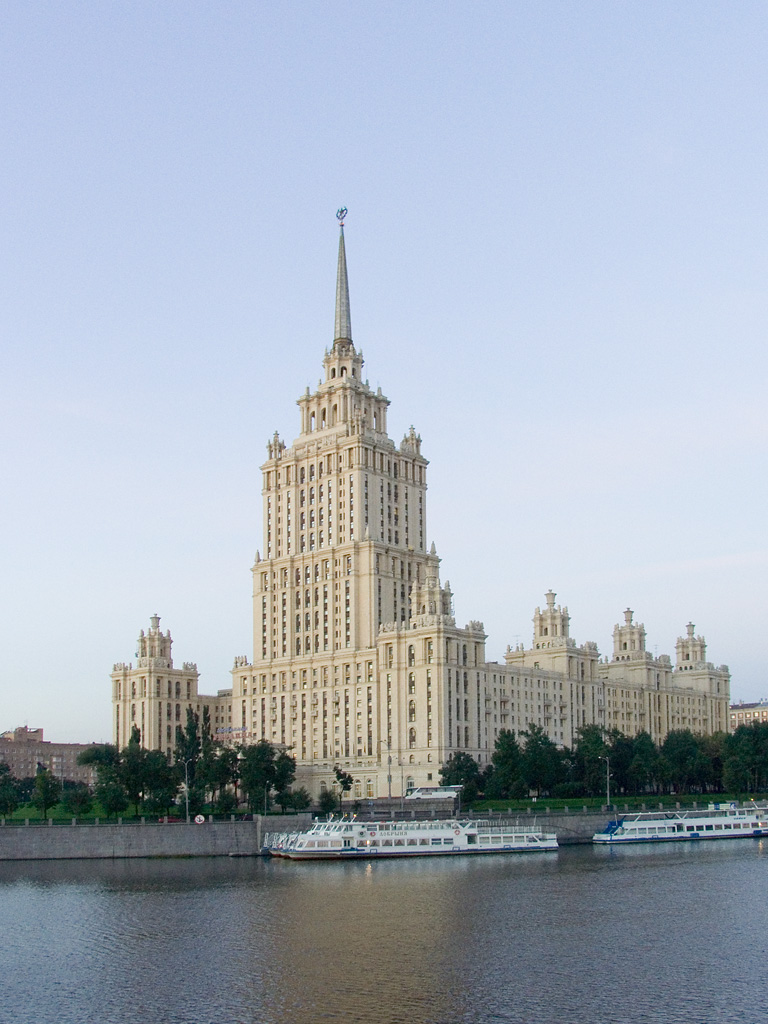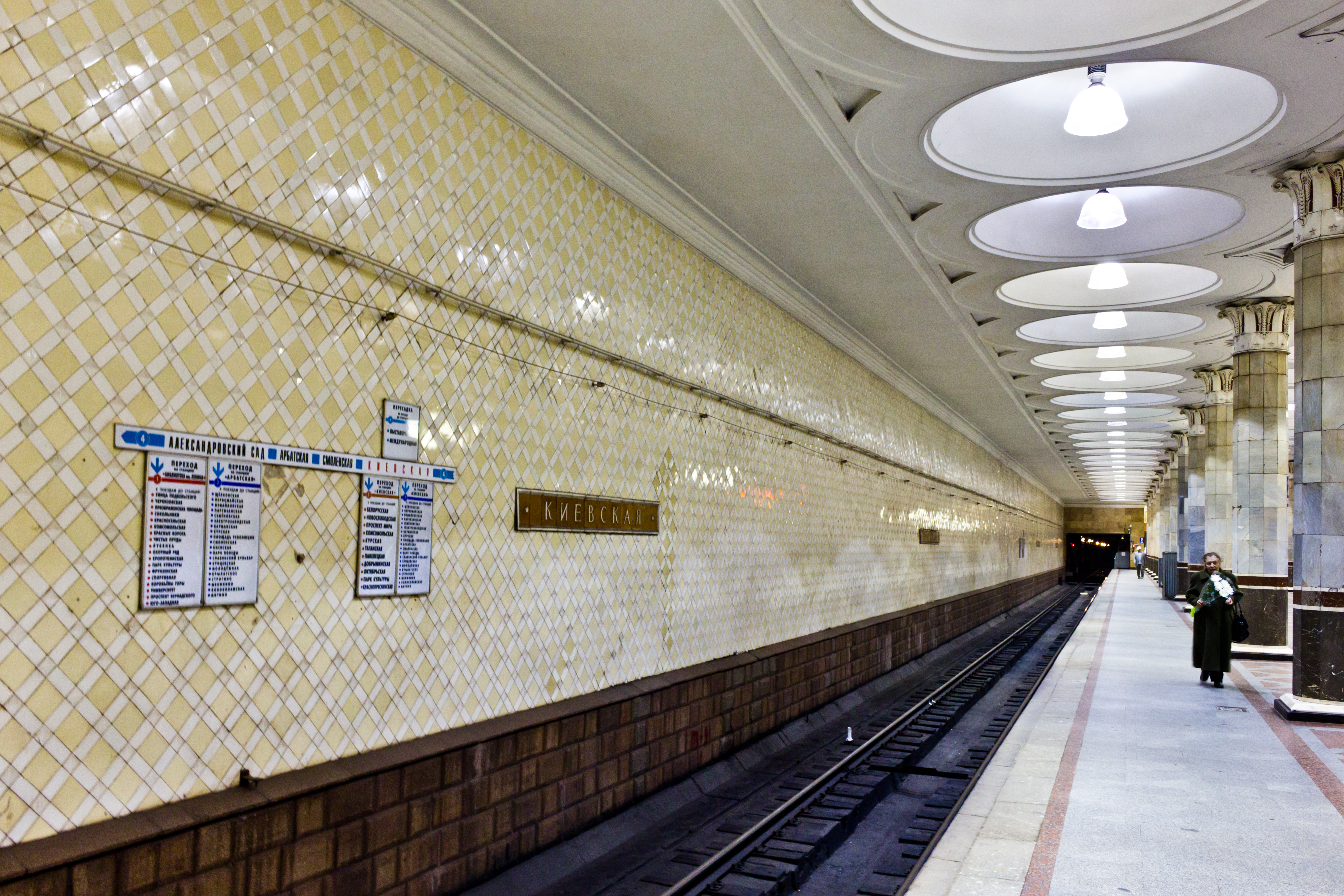|
Alexandrovsky Sad (Moscow Metro)
Aleksandrovsky Sad (russian: Алекса́ндровский сад, ) is a station of the Filyovskaya line of the Moscow Metro. It was designed by A. I. Gontskevich and S. Sulin and opened on 15 May 1935 along with the first stage of the metro. The station is situated under the southern part of the Vozdvizhenka Street (which was then called Kominterna—hence the original name) next to the building of the Russian State Library. The northern of the two side platforms of the station works during rush hours only. History Originally the station was not included in the plans for the first stage due to its closeness to the Biblioteka Imeni Lenina station. When a change to the plans was introduced with a new station it was decided not to augment the design of the planned large tunnel with parallel tracks separated by a row of columns, but to modify it by increasing its height and building platforms on the sides in what is known as a '' Parisian Style''. Construction ... [...More Info...] [...Related Items...] OR: [Wikipedia] [Google] [Baidu] |
Moscow Metro Station
There are 250 active stations of the Moscow Metro. Of these, 209 on Moscow Metro proper, and some additional ones that are marketed by Moscow Metro: 6 stations of Moscow Monorail and 31 stations of the Moscow Central Circle. Two stations have been closed. As of 2017 several new stations are under construction or being planned. One station is reserved for future service ( Delovoy Tsentr for the Bolshaya Koltsevaya line). By number of stations the Moscow Metro is ranked 8th, cf. List of metro systems. The deepest station of Moscow Metro, Park Pobedy, is the third-deepest metro station of the world. Active stations Physical characteristics Of the Moscow Metro's 229 stations, 78 are deep underground, 109 are shallow, and 42 (25 of them on the Central Circle) are at or above ground level. Of the latter there are 12 ground-level stations, four elevated stations, and one station ( Vorobyovy Gory) on a bridge. The deep stations comprise 55 triple-vaulted pylon stations, 19 tripl ... [...More Info...] [...Related Items...] OR: [Wikipedia] [Google] [Baidu] |
Mokhovaya
Mokhovaya Street (russian: Моховая улица) is a one-way street in central Moscow, Russia, a part of Moscow's innermost ring road - Central Squares of Moscow. Between 1961 and 1990 it formed part of Karl Marx Avenue (Проспект Маркса). The street runs from the (named after nearby Borovitskaya Tower) in the south past Vozdvizhenka Street, Bolshaya Nikitskaya Street and Manege Square, ending at Tverskaya Street in the north. Traffic on Mokhovaya follows a northwards counterclockwise pattern as the parallel Manezhnaya Street is closed to regular traffic. History The name of a street, literally Moss Street, emerged in the 18th century after the Moss Market that stood on site of Moscow Manege and traded in moss for caulking log houses. The street is much older, dating back to the court of Sophia of Lithuania, wife of Vasili I of Russia (1490s). At that time the area was known as Vagankovo (different from present-day Vagankovo Cemetery). Ivan IV of Russi ... [...More Info...] [...Related Items...] OR: [Wikipedia] [Google] [Baidu] |
Arbatskaya (Arbatsko–Pokrovskaya Line)
Arbatsky (masculine), Arbatskaya (feminine), or Arbatskoye (neuter) may refer to: *Arbatskaya (Arbatsko-Pokrovskaya Line), a station on the Arbatsko-Pokrovskaya Line of the Moscow Metro, Moscow, Russia * Arbatskaya (Filyovskaya Line), a station on the Filyovskaya Line of the Moscow Metro, Moscow, Russia *Arbatskaya Square, a square in central Moscow *Arbatskaya Spit, common misspelling of Arabat Spit The Arabat Spit ( uk, Арабатська коса; russian: Арабатская коса) or Arabat Arrow is a spit (landform), barrier spit that separates the large, shallow and very salty Syvash lagoons from the Sea of Azov. The spit runs ... See also * Arbat (other) {{Disambig ... [...More Info...] [...Related Items...] OR: [Wikipedia] [Google] [Baidu] |
Kremlin
The Kremlin ( rus, Московский Кремль, r=Moskovskiy Kreml', p=ˈmɐˈskofskʲɪj krʲemlʲ, t=Moscow Kremlin) is a fortified complex in the center of Moscow founded by the Rurik dynasty, Rurik dynasty. It is the best known of the Kremlin (fortification), kremlins (Russian citadels), and includes five palaces, four cathedrals, and the enclosing Kremlin Wall with Kremlin towers. In addition, within this complex is the Grand Kremlin Palace that was formerly the Tsar's Moscow residence. The complex now serves as the official residence of the President of Russia, President of the Russian Federation and as a Moscow Kremlin Museums, museum with almost 3 million visitors in 2017. The Kremlin overlooks the Moskva River to the south, Saint Basil's Cathedral and Red Square to the east, and the Alexander Garden to the west. The name "''Kremlin''" means "fortress inside a city", and is often also used metonymically to refer to the Government of Russia, government of the Russi ... [...More Info...] [...Related Items...] OR: [Wikipedia] [Google] [Baidu] |
Alexander Garden
Alexander Gardens (russian: Александровский сад) was one of the first urban public parks in Moscow, Russia. The park comprises three separate gardens, which stretch along all the length of the western Kremlin wall for between the building of the Moscow Manege and the Kremlin. History Until the 18th century, the Neglinnaya River flowed on the site of Alexandrovsky Gardens, over which four bridges were built. Historically, folk festivals were held on the river banks, its water was clean and famous for fishing. After the end of the Napoleonic Wars, Emperor Alexander I decided to take the river underground and enclose it in a pipe three kilometres long. Gardens were laid out in the vacated place, designed by the architect Osip Bove as part of a plan to restore Moscow after the fire of 1812. The gardens were built from 1819 to 1823 and were originally called the Kremlin Gardens. After the coronation of Alexander II in 1856, the gardens were renamed the Alexan ... [...More Info...] [...Related Items...] OR: [Wikipedia] [Google] [Baidu] |
Mikhail Kalinin
Mikhail Ivanovich Kalinin (russian: link=no, Михаи́л Ива́нович Кали́нин ; 3 June 1946), known familiarly by Soviet citizens as "Kalinych", was a Soviet politician and Old Bolshevik revolutionary. He served as head of state of the Russian Soviet Federative Socialist Republic and later of the Soviet Union from 1919 to 1946. From 1926, he was a member of the Politburo of the Communist Party of the Soviet Union. Born to a peasant family, Kalinin worked as a metal worker in Saint Petersburg and took part in the 1905 Russian Revolution as an early member of the Bolsheviks. During and after the October Revolution, he served as mayor of Petrograd (St. Petersburg). After the revolution, Kalinin became the head of the new Soviet state, as well as a member of the Central Committee of the Communist Party and the Politburo. Kalinin remained the titular head of state of the Soviet Union after the rise of Joseph Stalin, but held little real power or influence. He ... [...More Info...] [...Related Items...] OR: [Wikipedia] [Google] [Baidu] |
Comintern
The Communist International (Comintern), also known as the Third International, was a Soviet Union, Soviet-controlled international organization founded in 1919 that advocated world communism. The Comintern resolved at its Second Congress to "struggle by all available means, including armed force, for the overthrow of the international bourgeoisie and the creation of an international Soviet republic (system of government), Soviet republic as a transition stage to the complete abolition of the state". The Comintern was preceded by the 1916 dissolution of the Second International. The Comintern held seven World Congresses in Moscow between 1919 and 1935. During that period, it also conducted thirteen Enlarged Plenums of its governing Executive Committee of the Communist International, Executive Committee, which had much the same function as the somewhat larger and more grandiose Congresses. Joseph Stalin, leader of the Soviet Union, dissolved the Comintern in 1943 to avoid antag ... [...More Info...] [...Related Items...] OR: [Wikipedia] [Google] [Baidu] |
Stalinist Architecture
Stalinist architecture, mostly known in the former Eastern Bloc as Stalinist style () or Socialist Classicism, is the architecture of the Soviet Union under the leadership of Joseph Stalin, between 1933 (when Boris Iofan's draft for the Palace of the Soviets was officially approved) and 1955 (when Nikita Khrushchev condemned "excesses" of the past decades and disbanded the Soviet Academy of Architecture). Stalinist architecture is associated with the Socialist realism school of art and architecture. Features As part of the Soviet policy of rationalization of the country, all cities were built to a general development plan. Each was divided into districts, with allotments based on the city's geography. Projects would be designed for whole districts, visibly transforming a city's architectural image. The interaction of the state with the architects would prove to be one of the features of this time. The same building could be declared a formalist blasphemy and then receive the ... [...More Info...] [...Related Items...] OR: [Wikipedia] [Google] [Baidu] |
World War II
World War II or the Second World War, often abbreviated as WWII or WW2, was a world war that lasted from 1939 to 1945. It involved the vast majority of the world's countries—including all of the great powers—forming two opposing military alliances: the Allies and the Axis powers. World War II was a total war that directly involved more than 100 million personnel from more than 30 countries. The major participants in the war threw their entire economic, industrial, and scientific capabilities behind the war effort, blurring the distinction between civilian and military resources. Aircraft played a major role in the conflict, enabling the strategic bombing of population centres and deploying the only two nuclear weapons ever used in war. World War II was by far the deadliest conflict in human history; it resulted in 70 to 85 million fatalities, mostly among civilians. Tens of millions died due to genocides (including the Holocaust), starvation, ma ... [...More Info...] [...Related Items...] OR: [Wikipedia] [Google] [Baidu] |
Kievskaya (Filyovskaya)
{{Infobox station , name = Kiyevskaya , native_name = Киевская , native_name_lang=ru , type = Moscow Metro station , image = Moscow KievskayaFL metro station asv2018-08.jpg , image_size = , image_caption = , address = Dorogomilovo District{{nowrap, Western Administrative Okrug , borough = Moscow , country = Russia , coordinates = {{coord, 55.7436, 37.5655, display=inline,title , line = {{MOSMETRO-bull, 4, text=1 , other = , structure = Shallow column station, triple-span , platform = 1 island platform , depth = {{convert, 8.7, m , levels = 1 , tracks = 2 , parking = No , opened = {{start date and age, df=yes, 1937, 03, 20 , closed = {{start date and age, df=yes, 1953, 04, 05 to {{start date and age, df=yes, 1958, 11, 07 , rebuilt = , ADA = , code = 057 , owned = Moskovsky Metropoliten , zone = , former = ... [...More Info...] [...Related Items...] OR: [Wikipedia] [Google] [Baidu] |







